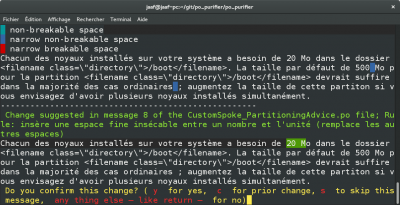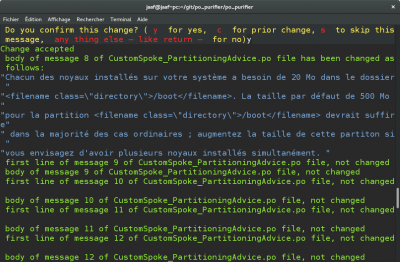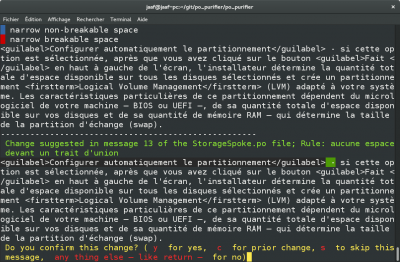No edit summary |
No edit summary |
||
| Line 8: | Line 8: | ||
Each time a typographic rule is not satisfied, the program stops and ask the user what to do. The figure 1 below shows how it looks like : | Each time a typographic rule is not satisfied, the program stops and ask the user what to do. The figure 1 below shows how it looks like : | ||
[[Image:po_purifier_1.png|center| | [[Image:po_purifier_1.png|center|thumb|400px|''Figure 1: Typographic Fault Detected'']] | ||
* The message to the user, that appears in English here, normally appears in the user's language, provided that the program has been localized. It has 2 parts: | * The message to the user, that appears in English here, normally appears in the user's language, provided that the program has been localized. It has 2 parts: | ||
| Line 17: | Line 17: | ||
* To help the user, the message is shown twice. First with the various spaces colorized according to their type then with the typo fault highlighted. | * To help the user, the message is shown twice. First with the various spaces colorized according to their type then with the typo fault highlighted. | ||
The figure 2 below shows what happens after the user has accepted the change. | |||
[[Image:po_purifier_2.png|center|thumb|400px|''Figure 2: Typographic Correction Accepted'']] | |||
* The message ''Change accepted'' is displayed. | |||
* The corrected message is displayed in blue color. | |||
* Then the program informs the user it has not changed some message because no typo faults were detected. It should do likewise till the next fault detection. | |||
The figure 3 below shows a case where the user could use the c (for prior change) option. Indeed, we can see that an hyphen has been used in place of a semi-em dash. In French the spacing rules for hyphen and semi-em dash are different. An hyphen requires no space between the previous and the following word, while a semi-em dash requires a spaces for both. It appears that changing the hyphen with a semi-em dash is the best solution here. | |||
[[Image:po_purifier_3.png|center|thumb|400px|''Figure 3: The user should replace the hyphen with a semi-em dash'']] | |||
The following figures show how the process occurs. | |||
<gallery> | |||
File:po_purifier_4.png|center|thumb|400px | |||
File:po_purifier_5.png|center|thumb|400px | |||
File:po_purifier_6.png|center|thumb|400px | |||
File:po_purifier_7.png|center|thumb|400px | |||
</gallery> | |||
Revision as of 06:51, 2 June 2016
Description of the tool
This tool is a python script that can be found at https://github.com/jaaf/po_purifier. It scan a directory for .po files. For each file, it checks translated messages against typographic rules that reside in a configuration file nammed typorules.py. Each time a typographic rule is not satisfied, the program stops and ask the user what to do. The figure 1 below shows how it looks like :

- The message to the user, that appears in English here, normally appears in the user's language, provided that the program has been localized. It has 2 parts:
- The first part that tells the user a typo rule is infringed and that he has to decide for change or not (it is part of the program and has to be localized)
- The typo rule itself (it belongs to the typorules.py file)
- In this case the French typo rule requires a narrow no break space between a value and its unit and the location of the fault is shown with a green highlight.
- To help the user, the message is shown twice. First with the various spaces colorized according to their type then with the typo fault highlighted.
The figure 2 below shows what happens after the user has accepted the change.

- The message Change accepted is displayed.
- The corrected message is displayed in blue color.
- Then the program informs the user it has not changed some message because no typo faults were detected. It should do likewise till the next fault detection.
The figure 3 below shows a case where the user could use the c (for prior change) option. Indeed, we can see that an hyphen has been used in place of a semi-em dash. In French the spacing rules for hyphen and semi-em dash are different. An hyphen requires no space between the previous and the following word, while a semi-em dash requires a spaces for both. It appears that changing the hyphen with a semi-em dash is the best solution here.

The following figures show how the process occurs.
-
400px
-
400px
-
400px
-
400px




